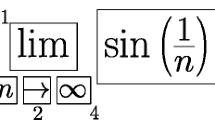Abstract
This study traces curricular support for concepts related to infinity and division by zero, in both elementary and secondary mathematics curriculum documents in our province. It was motivated by results of our previous and ongoing work related to transition to post-secondary studies in mathematics, in which we identified consistent gaps and misconceptions around limits and infinity. Our findings are startling in that, in the school curricula, many expected references to concepts related to division by zero, infinity, and limits are simply not present (expected in the sense of being needed to provide essential support for the material which, according to curriculum documents, must be covered). Recommendations for future curriculum revisions are included.
Résumé
Cette recherche fait le point sur le soutien accordé aux concepts d’infini et de division par zéro dans les documents du curriculum de mathématiques au primaire et au secondaire dans notre province. Elle s’inspire des résultats de nos travaux antérieurs et actuels sur la transition vers des études post-secondaires en mathématiques, où nous avons identifié d’importantes lacunes et perceptions erronées autour des limites et de l’infini. Nos résultats sont étonnants dans ce sens que, dans les curriculums scolaires, de nombreuses références attendues à des concepts liés à la division par zéro, à l’infini et aux limites sont tout simplement absents (« attendues » dans le sens de nécessaires pour fournir la base essentielle de la matière qui, selon les documents figurant dans le curriculum, doit être couverte dans le programme). Nous incluons également des recommandations en vue de révisions futures du curriculum.
Similar content being viewed by others
References
Ball, D. (1990). Prospective elementary and secondary teachers’ understanding of division. Journal for Research in Mathematics Education, 21(2): 132–144.
Biza, I., Souyoul, A. & Zachariades, T. (2005). Conceptual change in advanced mathematical thinking. Discussion paper, Fourth Congress of ERME (European Society for Research in Mathematics Education), Sant Feliu de Guixols, Spain, 17–21.
Burazin, A. & Lovric, M. (2018). Analyzing narratives about limits involving infinity in calculus textbooks. Proceedings of the RUME (Research in Undergraduate Mathematics Education) Conference, San Diego. Manuscript Accepted for Publication.
Crespo, S. & Nicol, C. (2006). Challenging preservice teachers’ mathematical understanding: The case of division by zero. School Science and Mathematics, 106(2), 84–97.
Fischbein, E. (2001). Tacit models and infinity. Educational Studies in Mathematics, 48, 309–329.
Jones, S. R. (2015). Calculus limits involving infinity: The role of students’ informal dynamic reasoning, International Journal of Mathematical Education in Science and Technology, 46(1), 105–126. https://doi.org/10.1080/0020739X.2014.941427
Kajander, A. & Boland, T. (2014). Mathematical models for teaching: Reasoning without memorization. Toronto, ON: Canadian Scholars’ Press.
Kajander, A., & Lovric, M. (2005). Transition from secondary to tertiary mathematics: McMaster University experience. International Journal of Mathematics Education in Science and Technology, 36(2-3), 149–160.
Kajander, A., & Lovric, M. (2009). Mathematics textbooks and their potential role in supporting misconceptions. International Journal of Mathematics Education in Science and Technology, 40(2), 173–181.
Kajander, A. & Lovric, M. (2017). Understanding and supporting teacher horizon knowledge around limits: a framework for evaluating textbooks for teachers. International Journal of Mathematical Education in Science and Technology. 48(7), 1023–1042. https://doi.org/10.1080/0020739X.2017.1301583
Kim, D. J., Sfard, A., & Ferrini-Mundy, J. (2005). Students’ colloquial and mathematical discourses on infinity and limit. Proceedings of the 29th Conference of the International Group for the Psychology of Mathematics Education, Melbourne, Australia. Cape Town, South Africa: International Group for the Psychology of Mathematics Education.
Lovric, M. (2012). Collaboration between research in mathematics education and teaching mathematics: Case study of teaching infinity in calculus. In S. Oesterle, D. Allan, & P. Liljedahl (Eds.), Proceedings of the 2012 Annual Meeting of the Canadian Mathematics Education Study Group (pp. 139–146). Université Laval.
Ontario Ministry of Education (2005a). The Ontario Curriculum Grades 1–8: Mathematics. Toronto, ON: Queen’s Printer for Ontario.
Ontario Ministry of Education (2005b). The Ontario Curriculum Grades 9–10: Mathematics. Toronto, ON: Queen’s Printer for Ontario.
Ontario Ministry of Education (2007). The Ontario Curriculum Grades 11–12: Mathematics. Toronto, ON: Queen’s Printer for Ontario.
Tall, D. O. (1991). Reflections. In D. O. Tall (Ed.), Advanced mathematical thinking (pp. 251–259). Holland: Kluwer Academic Publishers.
Author information
Authors and Affiliations
Corresponding author
Ethics declarations
Conflict of Interest
The authors declare that they have no conflict of interest.
Rights and permissions
About this article
Cite this article
Kajander, A., Lovric, M. “It Does Not Exist”: Infinity and Division by Zero in the Ontario Mathematics Curriculum. Can J Sci Math Techn 18, 154–163 (2018). https://doi.org/10.1007/s42330-018-0012-5
Published:
Issue Date:
DOI: https://doi.org/10.1007/s42330-018-0012-5




